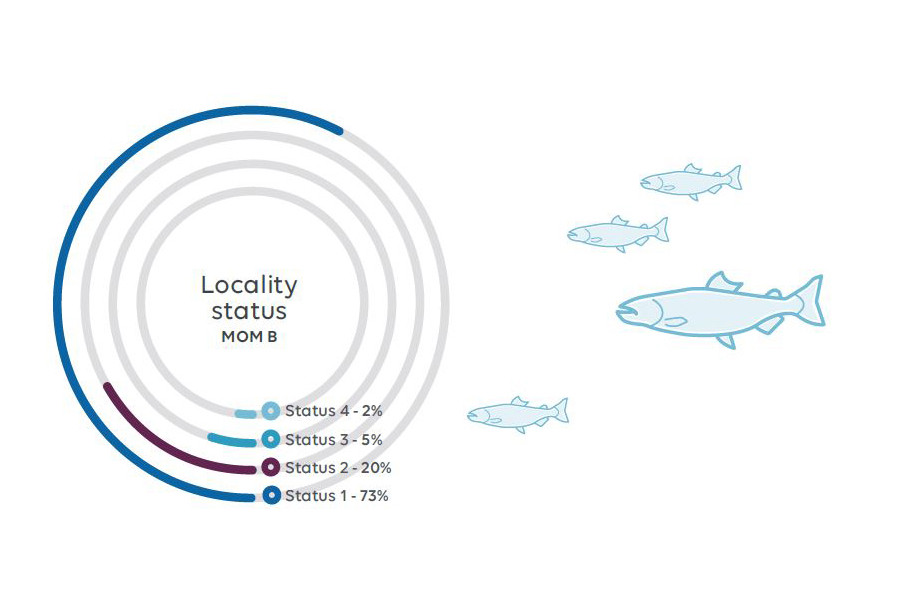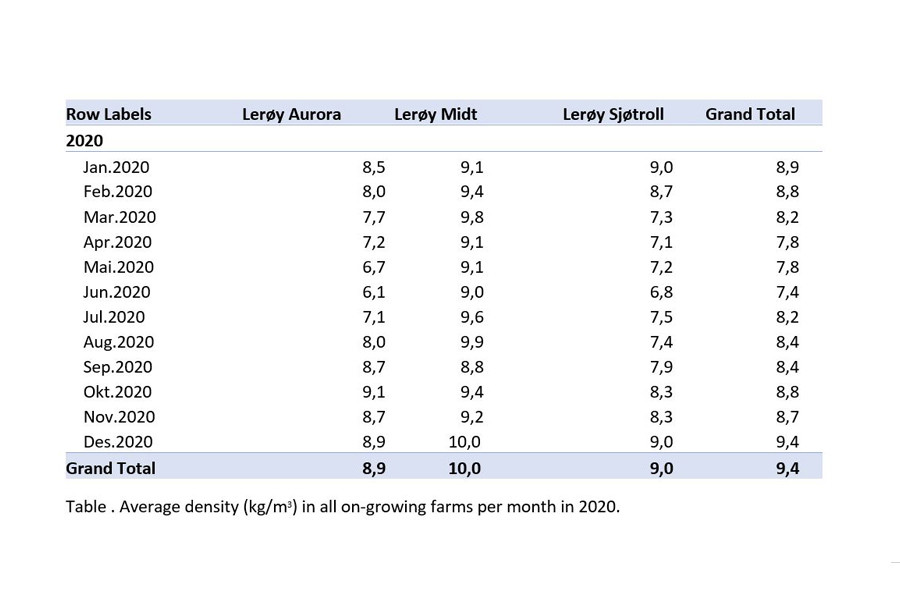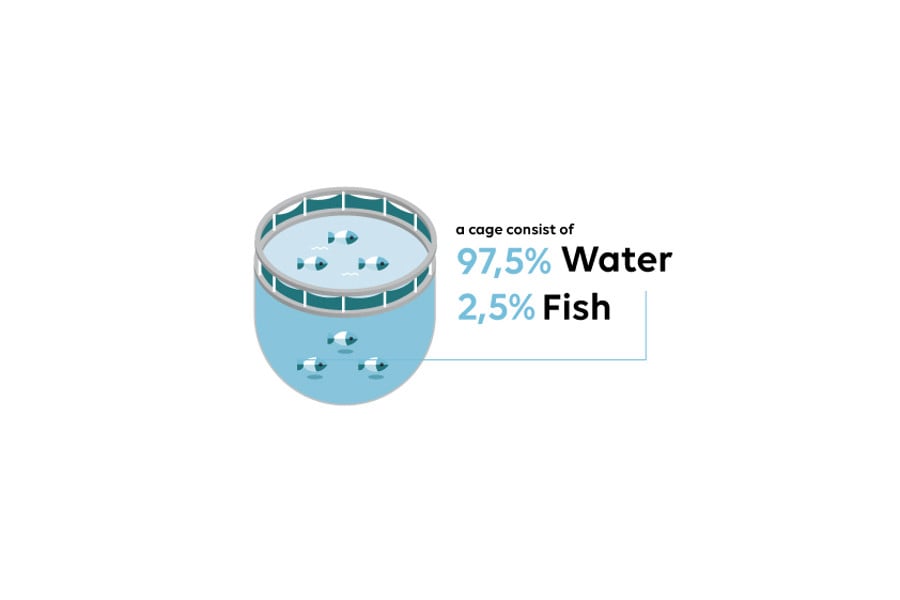Before stocking a production site, approval is required from a number of official and private bodies. Furthermore, approval requires compliance with numerous analyses, requirements and local conditions.
These approvals are given after mapping and compliance of ecological status, spawning areas for marine species, diversity, and presence of endangered species in the region.
One of the assessments carried out both prior to approval for operations at a location and during fish farming at the facility is a so-called MOM-B evaluation.
MOM-B stands for:
M – matfiskanlegg (production facility)
O – overvåkning (monitoring)
M – modellering (modelling)
A MOM-B evaluation is carried out by a third party and involves extraction of samples from the seabed under and around the cages in a facility.
The analysis has three parts:
All parameters are allocated a score according to how much sediment is affected by the organic substance. The distinction between acceptable and unacceptable sediment condition is set to the highest accumulation that allows burrowing benthic organisms to live in the sediment. The analyses are carried out when production of one generation is at its peak.
On the basis of these investigations, the individual location receives a score, which also provides an indication of when the next MOM-B investigation should be carried out. A poor score often requires more frequent seabed investigations than a good score. In addition to MOM-B, analyses are also conducted locally at individual facilities. These include measurement of density, oxygen level in the sea, currents, water quality, visibility, dives under the facility etc.
Each facility is also linked with neighboring facilities in a zone-based cooperation to work together on topics such as lice and preventing accidental release, spread of disease, outbreaks of disease etc. MOM-B samples must always be taken before releasing fish to a location.
If the score is 3 or 4, fish must not be released without an additional evaluation of the status of the location, describing the reason for the lack of restitution. If a score of 3 or 4 is reported for a location, a MOM-C sample shall be taken.
Main goal:Average MOM-B max 1.5 per location

MOM C
In addition to B surveys, MOM C surveys are also conducted at all facilities. The C-survey is a trend monitoring of the bottom conditions in the transition zones from the farming zone and outwards in the recipient. This study is based on mapping of fauna on soft bottoms, which is carried out in accordance with relevant ISO standards. In addition, hydrographic, geological and chemical support parameters are included. These extended trend monitoring outside the local areas is done at least every 5 years, but the frequency may increase based on the condition from each survey.
KPI: Biodiversity
Copper
Copper is a naturally occurring chemical element which can be toxic at high levels in the marine environment. Nets are treated with antifouling agents containing copper. However, cleaning of nets is necessary to ensure good water quality for the farmed fish. Lerøy Seafood Group uses low-pressure underwater washers to minimise the risk of copper flaking off.
Projects have been implemented to measure the amount of copper emissions for each wash. Depending on the results, Lerøy Seafood Group will explore alternative methods for keeping the nets clean. At sites where elevated copper amounts have been detected in the sediments, the Group has started to use antifouling agents without copper, or has changed the nets as an alternative to in-situ cleaning.
In addition to cleaning in-situ, all nets are cleaned at onshore sites after each production period. Onshore cleaning sites have zero copper emissions, as required by Norwegian legislation.
Copper impregnation has a positive effect on sea lice and is used as there are currently no adequate alternatives. The Group is actively working with suppliers to develop an alternative to replace copper.
Main goal: Replace antifouling agents that contain copper
Fallowing
As a strategy to minimize infection pressure and environmental impact, all sites are fallowed and washed/disinfected every two years. In all regions where the Group has operations, fallowing and stocking periods are coordinated in zones, defined by the The Norwegian Food Safety Authority, NFSA and companies in each Area Based Management, ABM scheme.
Every site in a defined coordinated area is fallowed every second year for at least two months. Within each area-based management area, there is at least a one-month coordinated fallowing period every second year.
In 2020, every marine site was fallowed for more than four months (138 days) on average for the Group.
Main goal: Average fallowing per location: Minimum 60 days
Fallowed days in average per site
| Year | Lerøy Aurora | Lerøy Midt | Lerøy Sjøtroll | Total |
| 2014 | 95 | 84 | 134 | 107 |
| 2015 | 84 | 94 | 120 | 105 |
| 2016 | 111 | 179 | 123 | 141 |
| 2017 | 92 | 204 | 125 | 132 |
| 2018 | 123 | 158 | 135 | 138 |
| 2019 | 227 | 121 | 126 | 140 |
| 2020 | 134 | 122 | 161 | 138 |
DENSITY
The maximum legislative limit for fish density in a cage is 25 kg/m3 but the results for 2019 were far below this limit, indicating that the fish have plenty of space in the cages.
Fish health and fish welfare are at the core of our operations as a producer of Atlantic salmon and rainbow trout. As such, we are committed to both ethical and statutory obligations governed by Norwegian legislation.
A healthy fish is also a good fish for production and a prerequisite for good financial results. There are therefore numerous incentives for putting fish health and fish welfare at the top of the agenda for fish-farming operations. In an effort to ensure that we continuously fulfil these obligations, the Group has chosen to invest substantial resources in preventive measures for fish health, and this is now a major part of the production strategy for the entire Group.
In a cage with fish, there will be at least 97.5% water and at most 2.5% fish
Main goal density: Less than 25 kg/m3

We care about our fish and accept our ethical responsibility that comes with animal farming. The Group's goal is qualitative and requires continuous monitoring and targeted efforts throughout our farming value chain.
